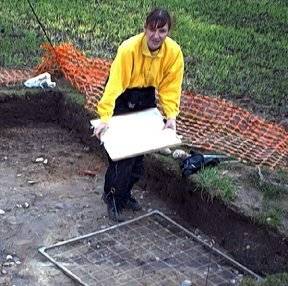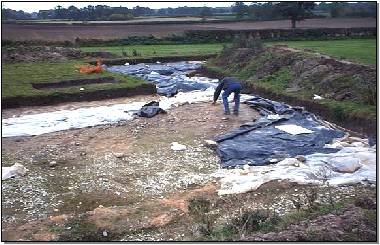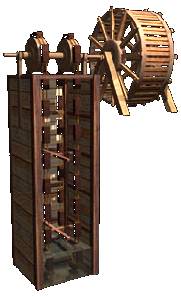|
 Excavations at High Legh near
Knutsford are proceeding apace with over 150 square metres exposed and over 80 tons of
soil removed. Derek Pierce, site director for the South Trafford Archaeological Group,
says that they have so far identified 5 distinct phases ranging in date from the 1st to
the 3rd century AD. The site is situated alongside a 16 metre wide Roman road, which was
discovered last year running towards the Roman settlement of Wilderspool, just south of
Warrington. Early pottery suggests the earliest phase dates to around 70 AD, a time before
the Romans had advanced into northern Britain. Derek thinks that the occupation at this
stage represents the preparations for Agricola’s campaign against the ancient tribe
of the Brigantes, who ruled across the Mersey in the areas of Lancashire and Yorkshire.
Features associated with this period are cobbled surfaces, ditches and post-holes.
Re-occupation of the site occurred around the end of the 2nd century, perhaps coinciding
with the campaigns of Septimus Severus, which ended with the defeat of the Picts in
Scotland. The general sparseness of pottery is indicative of temporary military site. In
this phase a new cobbled surface was laid over the old and later, strange clay banking
features appear. There is also some evidence of further activity in the 3rd century. An
open day has been arranged for Sunday 2nd December when the site will be explained in more
detail and all finds will be on display. Please see me at the meeting for site directions. Excavations at High Legh near
Knutsford are proceeding apace with over 150 square metres exposed and over 80 tons of
soil removed. Derek Pierce, site director for the South Trafford Archaeological Group,
says that they have so far identified 5 distinct phases ranging in date from the 1st to
the 3rd century AD. The site is situated alongside a 16 metre wide Roman road, which was
discovered last year running towards the Roman settlement of Wilderspool, just south of
Warrington. Early pottery suggests the earliest phase dates to around 70 AD, a time before
the Romans had advanced into northern Britain. Derek thinks that the occupation at this
stage represents the preparations for Agricola’s campaign against the ancient tribe
of the Brigantes, who ruled across the Mersey in the areas of Lancashire and Yorkshire.
Features associated with this period are cobbled surfaces, ditches and post-holes.
Re-occupation of the site occurred around the end of the 2nd century, perhaps coinciding
with the campaigns of Septimus Severus, which ended with the defeat of the Picts in
Scotland. The general sparseness of pottery is indicative of temporary military site. In
this phase a new cobbled surface was laid over the old and later, strange clay banking
features appear. There is also some evidence of further activity in the 3rd century. An
open day has been arranged for Sunday 2nd December when the site will be explained in more
detail and all finds will be on display. Please see me at the meeting for site directions.

Merseyside Arch. Soc.
On the 10th November this
group are hosting a one-day conference at Liverpool University to celebrate 25 years of
its existence. The theme is “A quarter Century of Archaeology on Merseyside”
with a full programme of speakers covering topics ranging from the prehistoric through the
Roman, pre-conquest and Medieval periods. The cost is £15 but this includes buffet lunch.
If you are interested please contact me for a booking form.
Roman Machine Found
 Excavations in the City of London
have unearthed two examples of Roman engineering, preserved by the rising water table. The
one-metre high waterwheels were found in two deep wells between the site of a Roman
bathhouse and amphitheatre. Powered by a huge treadmill, the sophisticated mechanism would
have been capable of lifting 60,000 gallons of water a day to a height of 5 meters. The
discovery is the best physical example of machinery recorded in contemporary written
accounts. The wells, each with a complex system of chains, links and buckets, were
excavated on a site being redeveloped by Land Securities in Gresham Street. They date from
AD63 and AD108, according to tests of the large timbers that line them. The
earlier example formed part of the rebuilding of London’s infrastructure after its
destruction by Boadicea in AD60-61. The oak buckets from this well are unique, being the
only surviving examples from the Roman world, and each was capable of holding 2 litres of
water. The buckets from the later well are thought to be more than twice this size.
Working models of the waterwheels will be on display at the Museum of London from 26th
September 2001 to 7th January 2002. A Jewish Bath a stone ritual bath,
or mikvah, which was built before the expulsion of the Jews in 1290, has also been found
on this site. Excavations in the City of London
have unearthed two examples of Roman engineering, preserved by the rising water table. The
one-metre high waterwheels were found in two deep wells between the site of a Roman
bathhouse and amphitheatre. Powered by a huge treadmill, the sophisticated mechanism would
have been capable of lifting 60,000 gallons of water a day to a height of 5 meters. The
discovery is the best physical example of machinery recorded in contemporary written
accounts. The wells, each with a complex system of chains, links and buckets, were
excavated on a site being redeveloped by Land Securities in Gresham Street. They date from
AD63 and AD108, according to tests of the large timbers that line them. The
earlier example formed part of the rebuilding of London’s infrastructure after its
destruction by Boadicea in AD60-61. The oak buckets from this well are unique, being the
only surviving examples from the Roman world, and each was capable of holding 2 litres of
water. The buckets from the later well are thought to be more than twice this size.
Working models of the waterwheels will be on display at the Museum of London from 26th
September 2001 to 7th January 2002. A Jewish Bath a stone ritual bath,
or mikvah, which was built before the expulsion of the Jews in 1290, has also been found
on this site.
Horus
Just a reminder that the
next meeting of this new Egyptology group, based in Ashton, is on Thursday 27th November.
This month’s prestigious speaker is the world renowned Joanne Fletcher, who will be
talking on ancient wigs. As the evening will include a meal you will need to book your
place. Contact John Johnson on 01942 741954 for further details.
Next Meeting
Wednesday 7th November at
the BP Centre (Scout HQ) in Greenough Street, at 7.30 pm as usual. This month’s
speaker is the eminent Robina McNeil, who is the County Archaeologist for the whole of the
Greater Manchester area. Her subject is post-medieval and industrial archaeology of the
Greater Manchester Metropolitan Borough.
Hope to see you there -B.A
|



